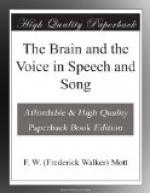* * * * *
Having thus shown that the fundamental note is dependent upon the tension of the vocal cords—the reed portion of the instrument—and the quality, timbre, or “klang” upon the resonator, I will pass on to the formation of syllables and words of articulate speech by the combination of vowel sounds and consonants.
“The articulate sounds called consonants are sounds produced by the vibrations of certain easily movable portions of the mouth and throat; and they have a different sound according as they are accompanied by voice or not” (Hermann).
The emission of sounds from the resonator may be modified by interruption or constriction in three situations, at each of which added vibrations may occur, (1) At the lips, the constriction being formed by the two lips, or by the upper or lower lip with the lower or upper dental arch. (2) Between the tongue and the palate, the constriction being caused by the opposition of the tip of the tongue to the anterior portion of the hard palate or the posterior surface of the dental arch. (3) At the fauces, the constriction being due to approximation of the root of the tongue and the soft palate. Consonants can only be produced in conjunction with a vowel sound, consequently the air is thrown into sonorous waves of a complex character, in part dependent upon the shape of the resonator for the production of the vowel, in part dependent upon the vibrations at each of these situations mentioned above. Consonants may accordingly be classified as they are formed at the three places of interruption—lips, teeth, and fauces respectively: (1) labial; (2) dental; (3) guttural.
The sounds formed at each of the places of interruption are divided into— 1. Explosives.—At one of the situations mentioned the resonator is suddenly opened or closed during the expulsion of air—(a) without the aid of voice, p, t, k; (b) with the aid of voice, b, d, g. When one of these consonants begins a syllable, opening of the resonator is necessary, e.g. pa; when it ends a syllable, closure is necessary, e.g. ap. No sharp distinction is possible between p and b, t and d, and k and g if they are whispered.
2. Aspirates.—The resonator is constricted at one of the points mentioned so that the current of air either expired or inspired rushes through a small slit. Here again we may form two classes: (a) without the aid of the voice, f, s (sharp), ch, guttural; (b) with the aid of voice, v, z, y. The consonants s and l are formed when the passage in front is closed by elevation of the tongue against the upper dental arch so that the air can only escape at the sides between the molar teeth: sh is formed by the expulsion of the current of air through two narrow slits, viz. (1) between the front of the tongue and the hard palate, the other between the nearly closed teeth. If a space be left between the tip of the tongue and the upper teeth two consonant sounds can be produced, one without the aid of the voice—th (hard) as in that; the other with the aid of voice—th (soft) as in thunder. Ch is a guttural produced near the front of the mouth, e.g. in Christ, or near the back as in Bach.




